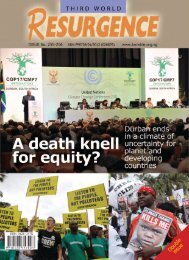Plantations, poverty and power - Critical Information Collective
Plantations, poverty and power - Critical Information Collective
Plantations, poverty and power - Critical Information Collective
You also want an ePaper? Increase the reach of your titles
YUMPU automatically turns print PDFs into web optimized ePapers that Google loves.
49<br />
Indah Kiat, Asia Pulp <strong>and</strong> Paper, Indonesia: Deforestation, debt <strong>and</strong> destruction of livelihoods<br />
In the late 1980s, the province of Riau in central Sumatra was 80 per cent covered in forest. Today, only<br />
30 per cent is left. “The main driver of deforestation <strong>and</strong> peat-bog draining here is the voracious appetite<br />
for timber, <strong>and</strong> the big players are two giant pulp mill owners”, reports Fred Pearce in New Scientist<br />
magazine. “One company is Asia Pacific Resources International (APRIL), part of RGM International, an<br />
empire owned by Singapore-based magnate Sukanto Tanoto. APRIL’s rival is the Sinar Mas Group<br />
dynasty founded by Eka Tjipta Widjaja, which owns Asia Paper <strong>and</strong> Pulp (APP).” 232<br />
APP boasts on its website that it is the largest pulp <strong>and</strong> paper producer in Asia outside Japan. 233 APP’s<br />
products include printing <strong>and</strong> writing papers, coated <strong>and</strong> uncoated sheets, photocopy paper, stationery,<br />
carbonless paper <strong>and</strong> tissue paper products. 234 Although APP doesn’t say this on its website, the company<br />
is also one of the most controversial <strong>and</strong> destructive pulp <strong>and</strong> paper companies on the planet.<br />
Construction of APP’s Indah Kiat pulp mill started in 1994. At the time, it was the largest single-line pulp<br />
mill in the world. In the previously small village of Kerinci, four thous<strong>and</strong> Indonesians worked day <strong>and</strong><br />
night to build the mill. The pulp mill was designed by the Finnish consulting firm Jaakko Pöyry. A soda<br />
boiler was supplied by Finl<strong>and</strong>’s Tampella. More machinery came from Finl<strong>and</strong>’s Kone, Valmet,<br />
Ahlstrom, Sunds Rauma <strong>and</strong> Outukumpu, Sweden’s Sunds Defibrator, Noss <strong>and</strong> Asea Brown Boveri<br />
Flakt; Japan’s Mitsubishi Heavy Industries <strong>and</strong> Nippon Sanso; Canada’s Chemetics <strong>and</strong> Bailey; the<br />
USA’s Cranston <strong>and</strong> Solarturbines; Germany’s Siemens <strong>and</strong> Voith; Britain’s ICI; Taiwan’s Teco; <strong>and</strong><br />
India’s Ion Exchange. 235<br />
Today, APP’s Indah Kiat pulp mill has a capacity of 2 million tonnes a year. Indah Kiat also has a 1.5<br />
million tonnes a year paper mill. Since starting operations in Sumatra in the 1980s, WWF estimates that<br />
APP has pulped about one million hectares of natural forest in Riau province. 236<br />
APP is ultimately owned by the Widjaja family, one of Indonesia’s largest business families, through a<br />
complex series of shareholdings. 237 The man who established the Sinar Mas Group, Eka Tjipta Widjaja,<br />
was the fifth richest business person in Indonesia in 2007, according to Forbes magazine. 238 Apart from<br />
pulp <strong>and</strong> paper the Sinar Mas Group is involved in agribusiness (including palm oil – another massively<br />
destructive plantation crop), property <strong>and</strong> finance. In 1990, Eka Tjipta Widjaja was reported as saying,<br />
232 Fred Pearce (2007) “Bog barons: Indonesia’s carbon catastrophe”, New Scientist, 1 December 2007.<br />
http://www.newscientist.com/channel/opinion/mg19626321.600-bog-barons-indonesias-carbon-catastrophe.html<br />
233 APP website http://www.asiapulppaper.com/<br />
234 Romain Pirard <strong>and</strong> Rofikoh Rokhim (2006) “Asia Pulp & Paper Indonesia: The business rationale that led to forest<br />
degradation <strong>and</strong> financial collapse ”, CIFOR, Working Paper No. 33.<br />
http://www.robinwood.de/german/trowa/sumatra/appcifor2006.pdf<br />
235 Ricardo Carrere <strong>and</strong> Larry Lohmann (1996) Pulping the South: Industrial Tree <strong>Plantations</strong> in the World Paper<br />
Economy, Zed Books, page 211.<br />
236 “Asia Pulp & Paper (APP) Hiding Destruction Behind False Advertisements: APP continues to ignore calls for<br />
conservation beyond ‘legal compliance’, <strong>and</strong> even fails on the latter”, WWF Monitoring Brief October 2006.<br />
http://www.wwf.or.id/index.phpfuseaction=newsroom.detail&id=NWS1161151678&language=e<br />
237 Romain Pirard <strong>and</strong> Rofikoh Rokhim (2006) “Asia Pulp & Paper Indonesia: The business rationale that led to forest<br />
degradation <strong>and</strong> financial collapse ”, CIFOR, Working Paper No. 33, page 2.<br />
http://www.robinwood.de/german/trowa/sumatra/appcifor2006.pdf<br />
238 “#5 Eka Tjipta Widjaja & family”, Forbes, 13 December 2007.<br />
http://www.forbes.com/lists/2007/80/07indonesia_Eka-Tjipta-Widjaja-family_EGES.html















